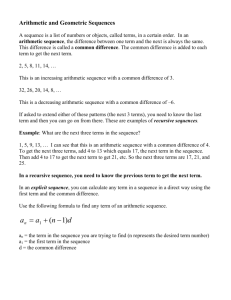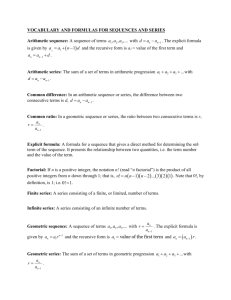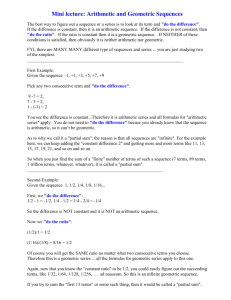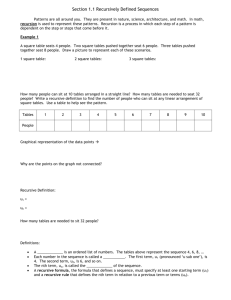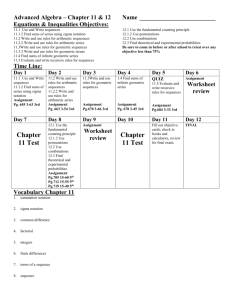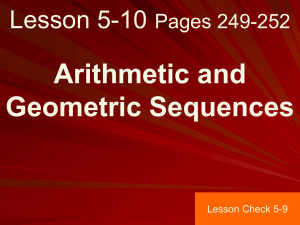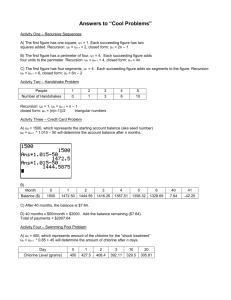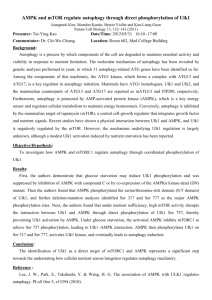Homework Test review
advertisement
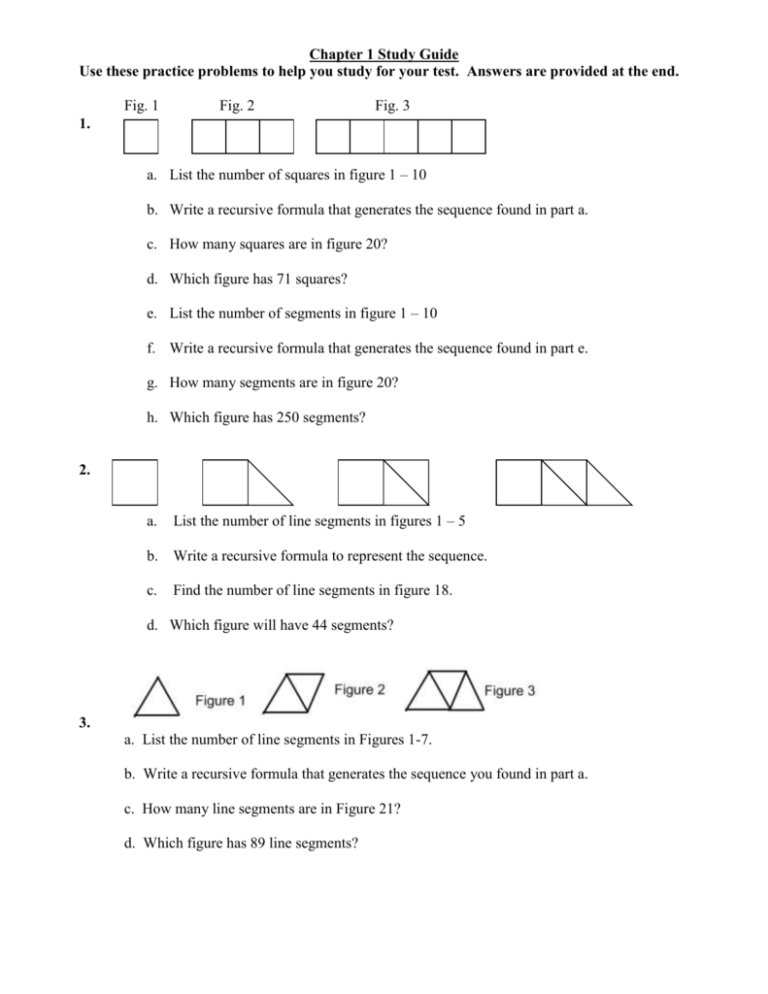
Chapter 1 Study Guide Use these practice problems to help you study for your test. Answers are provided at the end. Fig. 1 Fig. 2 Fig. 3 1. a. List the number of squares in figure 1 – 10 b. Write a recursive formula that generates the sequence found in part a. c. How many squares are in figure 20? d. Which figure has 71 squares? e. List the number of segments in figure 1 – 10 f. Write a recursive formula that generates the sequence found in part e. g. How many segments are in figure 20? h. Which figure has 250 segments? 2. a. List the number of line segments in figures 1 – 5 b. Write a recursive formula to represent the sequence. c. Find the number of line segments in figure 18. d. Which figure will have 44 segments? 3. a. List the number of line segments in Figures 1-7. b. Write a recursive formula that generates the sequence you found in part a. c. How many line segments are in Figure 21? d. Which figure has 89 line segments? 4. Consider the sequence 15, 11.25, 8.4375, a. Is it arithmetic or geometric? Justify your answer. b. Write a recursive formula for the sequence. Use u1 to represent the starting term. c. What is the 6th term of the sequence? d. Which term of the sequence is the first to be less than .1? 5. Consider the sequence 1000, 981, 962, 943 a. Is it arithmetic or geometric? Justify your answer. b. Write a recursive formula for the sequence. Use u1 to represent the starting term. c. What is the 6th term of the sequence? d. Which term of the sequence is the first to be less than 850? 6. Consider the sequence 4, 7, 10, 13… a. State whether the above sequence is arithmetic or geometric. Justify your answer. b. Write the recursive formula to represent the sequence. Use u1 as the starting term. c. What is the 10th term in the sequence. d. Which term is the first to be greater than 100? 7. Consider the sequence 48, 12, 3, 0.75… a. State whether the above sequence is arithmetic or geometric. Justify your answer. b. Write the recursive formula to represent the sequence. Use u1 as the starting term. c. What is the 8th term in the sequence. d. Which term is the first to be less than 0.05? 8. Consider the sequence 5, 2.5, 1.25, 0.625, 0.3125,.... a. Is the sequence arithmetic or geometric? Justify your answer. b. Write the recursive formula for this sequence. Use u1 to represent the first term. c. What is the 9th term of the sequence? d. Which term of the sequence is the first to be less than 0.002? 9. An insect zoo has 7.8 million bugs. Each year 5% of the bugs die and they bring in 100,000 more bugs. How many bugs will there be after 3 years? (Honors: How many bugs will there be in the long run?) 10. A small planet far, far away named Roscolian had a population of 5.3 million aliens. Each year 4% of the population dies or leaves the planet for a fresh start somewhere else. Also, each year, 145,000 new cute baby aliens are born or other aliens will immigrate to Roscolian. What will the population be in 5 years? (Honors: Find the long-run value.) 11. A small country has a population of 2.3 million people. Each year about 5% of the pervious year's population dies or leaves the country and about 100,000 people are born or immigrate to the country. If this pattern continues, what will the population be in 5 years? (Honors: What will the population be in the long run?) 12. Write a recursive formula for a sequence whose graph fits the given description. a. nonlinear decreasing toward zero. b. Nonlinear and increasing to zero c. Linear and decreasing e. Linear and increasing d. Nonlinear and decreasing to negative infinity. f. Constant g. nonlinear and increasing to infinity. h. nonlinear and decreasing to anything but zero i. nonlinear and increasing with a long-run value not infinity or zero j. nonlinear and decreasing with a long-run value not zero or infinity 13. Describe what the graph for each recursive formula should look like (linear/nonlinear, increasing/decreasing). Then identify the sequence as arithmetic or geometric. a. a0 = 25 and an=an-1 + 17.6 where n≥1 b. a0 = 25 and an = 0.4*an-1 where n≥1 c. a0 = 25 and an = an-1 - 14 where n≥1 d. a0 = 25 and an = 4*an-1 where n≥1 14. George’s principal in the bank is $3,000. The interest rate is 7% per year. a. How much total money will he have after year 1? b. Write a recursive formula for the total amount of money he will have after each year. c. How many years will it take for George to have $4,000? 15. Lisa is on a desert island with 120 coconuts. She eats 9% of her coconuts each day. a. Write a recursive formula for the total amount of coconuts she will have left. b. When will she have less than 10 coconuts? 16. A 2010 BMW 7 Series 4-door 750LixDrive Sedan costs $88,900.00 brand new. The value of the car depreciates by 15% each year a. Write a recursive formula b. What is the value of the car after 5 years? 17. You deposit $3,000 into a bank account that offers a monthly interest rate of 3.5%. a. Write a recursive formula. b. When will her balance be over $4000 dollars? 18. Find the % increase or decrease for each problem a. From 40 to 50 b. From 90 to 79 c. From 20 to 90 d. From 80 students to 135 students e. From 77 GPA to 84 GPA f. From 45 brownies to 4 brownies g. From 24 miles to 57 miles h. From 45 pints to 13 pints j. From 326 ft to 241 ft i. From 4048 minutes to 7548 minutes k. From 45 ft to 92 ft l. From 309 grams to 299 grams 19. You are offered 2 jobs! Lucky you! Both jobs offer a starting salary of $30,000 a year. Company 1 offers a $650 raise each year. Company 2 offers a 2% raise each year. a. Which offer should you take? b. Write a recursive formula for both companies. c. Make a table displaying the first 5 years at each company d. Would Company 2’s salary ever exceed Company 1’s? If so, when? e. What issues could effect your decision to choose a company? 20. Always, Sometimes, Never a. If the common difference of an arithmetic sequence is 5, you ______ subtract 5 from the previous to find the next term. b. If the common ratio of a geometric sequence is a 4, you ______ multiply by 4 from the previous term to find the next term. c. (Honors) A shifted geometric sequence _______ has a long-run value. d. In a discrete graph, the points should ______ be connected with a line. e. A fractal is _________ a geometric design that infinitely occurs. f. The principal of a bank account is _____ 0. g. Interest from a bank account ______ makes the value increase. h. The initial term of an sequence is _____ u1. i. In a recursive formula, there is _____ an initial term and ____ a recursive rule j. A decay or growth sequence is _____ arithmetic. k. (Honors) The long-run (limit) value of a shifted geometric sequence ______ hits the value. 21. Match each definition with a vocabulary word. A sequence that has a common difference 1. ________ The initial investment 2. ________ A geometric sequence that also includes addition or subtraction(Honors) 3. ________ A graph consisting of points 4. ________ The quotient of the now term divide and the previous term 5. ________ A geometric sequence that decreases 6. ________ A shape that is split into parts, each of which is a reduced size and exact copy of 7. ________ the whole Interest earned 8. ________ Honors Is a number that the sequence gets closer and closer to but never reaches 9. ________ A formula that defines a sequence (It has a starting term and a rule) 10. ________ A geometric sequence that increases 11. ________ A sequence that has a common ratio 12. ________ A number in the sequence 13. ________ An ordered list of numbers 14. ________ Points are on a straight line 15. ________ Part of the recursive formula that uses the previous term (or terms) to find the 16. ________ next term Process in which each step of a pattern is dependent on the step or steps before it 17. ________ The previous term subtracted from the now term (now – previous) 18. ________ The nth term of the sequence 19. ________ A. B. C. D. E. F. G. Accrued Interest Arithmetic Sequence Decay Difference Discrete Graph Fractal General Term H. I. J. K. L. M. Geometric Sequence Growth Limit Linear Principal Ratio N. O. P. Q. R. S. Recursion Recursive Formula Recursive Rule Shifted Geometric Sequence Sequence Term 22. Honors: Write a recursive formula for the following sequence. Use u1 as the initial term. 14, 9.64, 4.1464, -2.775536, -11.497175 Answers 1. a. 1, 3, 5, 7, 9, 11, 13, 15, 17, 19... b. u1= 1; un=un-1+2 where n>2 c. 39 d. 35 e. 4, 10, 16, 22, 28, 34, 40, 46, 52, 58... f. u1=4; un=un-1+6 where n>2 g. 118 h. 42 2. a. 4, 6, 8, 10, 12... b. u1 = 4;un=un-1+2 where n>2 c. 38 d. 21 3. a. 3, 5, 7, 9, 11, 13, 15 b. u1=3; un=un-1+2 where n>2 c. 43 d. 44 4. a. Geometric; the common ratio is .75 b. u1=15; un=un-1(.75) where n>2 c. 3.56 d. 19 5. a. Arithmetic; the common difference is -19 b. u1=1000; un=un-1-19 where n>2 c. 905 d. 9 6. a. Arithmetic; the common difference is 3 b. u1=4; un=un-1+3 where n>2 c. 31 d. 34 7. a. Geometric; the common ratio is 0.25 b. u1=48; un=un-1(.25) where n>2 c. 0.0029 d. 6 8. a. Geometric; the common ratio is 0.5 b. u1=5; un=un-1(0.5) where n>2 c. 0.01953 d. 13 9. 6,972,775 bugs; Honors: 2,000,000 bugs 10. 4,990,749 aliens; Honors: 3,625,000 aliens 11. 2,130,000 people; 2,000,000 people 12. (Answers may vary) 13. a. Arithmetic; Increasing; Linear b. Geometric; Decreasing; Nonlinear c. Arithmetic; Decreasing; Linear d. Geometric; Increasing; Nonlinear 14. a. $3,210 b. u0=3000; un=un-1(1.07) where n>1 c. 5 years 15. a. u0=120; un=un-1(.91) where n>1 b. 27 16. $39,445.40 17. a. u0=3000; un=un-1(1.035) where n>1 18. a. 25% increase b. 13% decrease c. 350% increase d. 68.75% increase e. 9% increase f. 92% decrease g. 138% increase h. 71% decrease i. 86% increase j. 26% decrease k. 104% increase l. 3% decrease 19. a. Company 2 b. Company 1: u0=30,000;un=un-1 + 650 where n>1 Company 2: u0=30,000; un=un-1(1.02) where n>1 c. Year 0 1 2 3 4 5 Company 1 30000 30650 31300 31950 32600 33250 33900 30000 30600 31212 31836.24 32472.96 33122.42 c. Yes, after year 9. You would make $35,850 at Company 1 and $35,852.78 at Company 2 d. Answers may vary 20. 21. 22. a. Never b. Always c. (Honors) Sometimes d. Never e. Always f. Sometimes g. Always h. Sometimes i. Always; Always j. Never k. (Honors) Never 1. B 2. L 3. Q 4. E 5. M 6. C 7. F 8. A 9. (Honors) J 10. O 11. I 12. H 13. S 14. R 15. K 16. P 17. N 18. D 19. G u1 = 14 un = un-1(1.26) + 8 where n > 2

